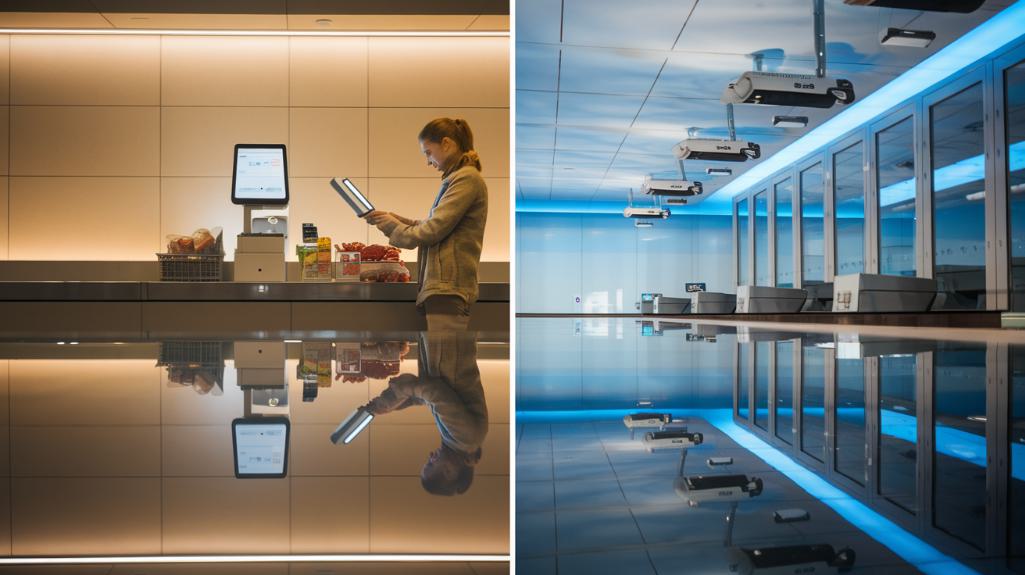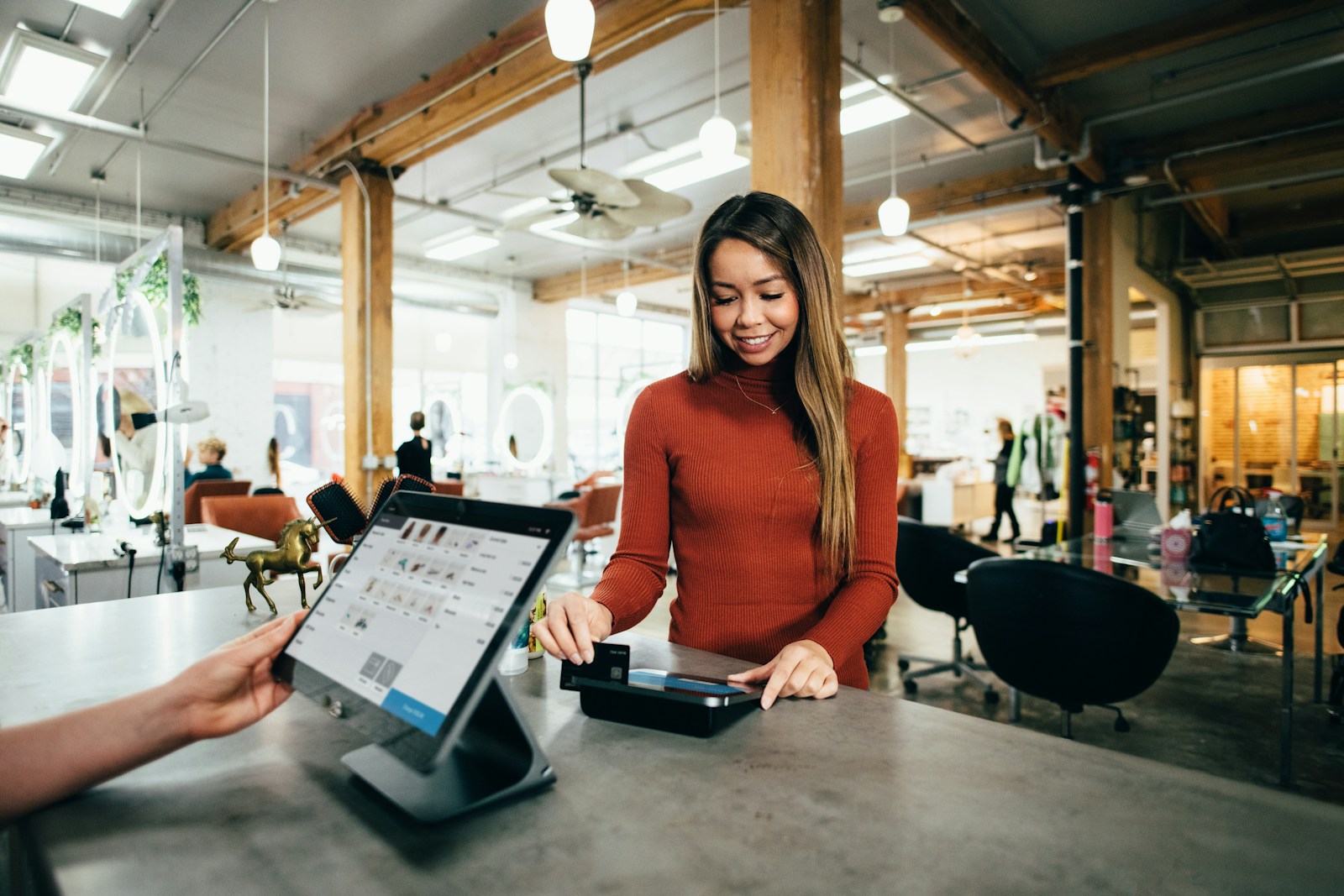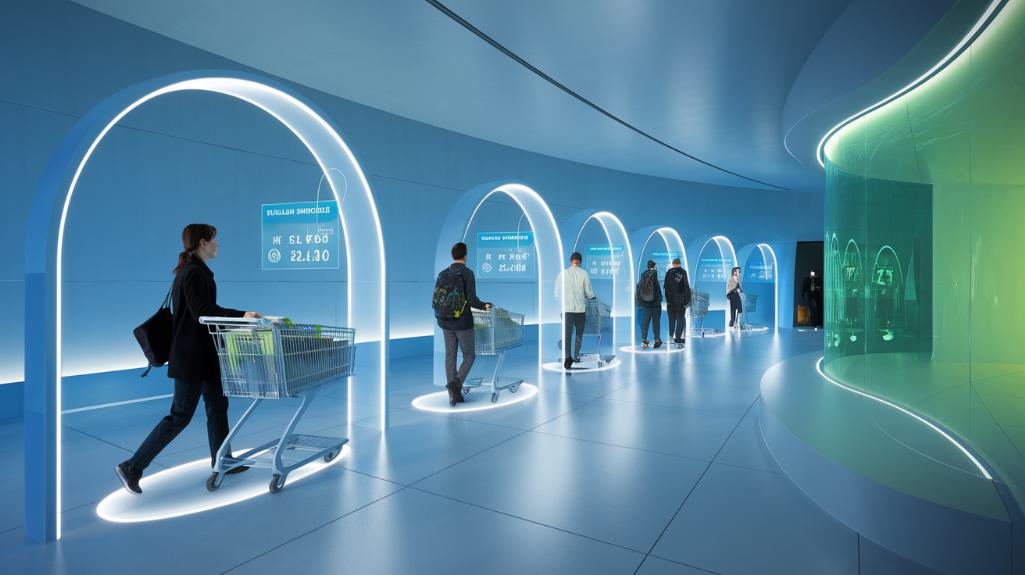Choosing between self-checkout and automated checkout systems depends on specific retail factors including store size, product complexity, and customer demographics. Self-checkout offers a 30% faster transaction speed and fits four units in one traditional lane space, while automated solutions eliminate checkout entirely but require higher initial investment. Modern retailers must evaluate ROI, considering that 80% of shoppers prefer non-traditional options. A thorough analysis of operational needs and customer preferences reveals the best solution.
Key Takeaways
- Store size and customer volume significantly impact choice – larger retailers benefit more from self-checkout due to high traffic patterns.
- Self-checkout systems cost $1,500-$20,000, while automated systems require higher initial investment but offer greater long-term labor savings.
- Automated checkout reduces shrinkage through AI-powered monitoring, while self-checkout experiences higher theft rates than traditional methods.
- Self-checkout processes transactions 30% faster than traditional methods, meeting the 73% of shoppers prioritizing speed and convenience.
- Consider hybrid solutions combining traditional, self-checkout, and automated systems based on product complexity and customer demographics.
Understanding Traditional vs. Modern Checkout Systems

As retail technology continues to evolve, the distinction between traditional and modern checkout systems has become increasingly significant for businesses seeking ideal operational efficiency.
Traditional benefits include personal interaction, effective handling of complex transactions, and reduced shrinkage through direct monitoring by cashiers. These systems remain popular among customers who value human assistance and prefer conventional shopping experiences.
Face-to-face retail transactions deliver personalized service and security while meeting the needs of shoppers who prefer traditional checkout experiences.
Modern innovations like self-checkout and AI-powered automated systems offer different advantages. Self-checkout provides customer autonomy and reduced wait times, while fully automated solutions like Amazon Go eliminate the checkout process entirely. Industry projections indicate retailer adoption will double to over 24,000 locations by 2030.
These systems leverage advanced technology to track purchases automatically, minimize labor costs, and streamline the shopping experience. However, they require substantial technological investment and may experience higher theft rates compared to traditional methods.
The Rise of Self-Checkout Technology
While traditional checkout systems dominated retail for decades, self-checkout technology has experienced remarkable growth since its introduction, with over 217,000 terminals deployed globally in 2023 alone. Customer satisfaction continues to drive expansion as studies show 80% of in-store shoppers prefer non-traditional checkout options. The integration of tools like Picklist Assistant further optimizes the item picking process, enhancing customer experience.
The rapid self-checkout adoption rate is evident, with 75.5% of retail stores now offering this technology. Despite technology challenges like equipment malfunctions and security concerns, retailers continue expanding their self-checkout infrastructure due to its proven benefits, including 30% faster transactions and reduced operational costs.
- Market penetration reaches 96% in grocery stores, indicating strong industry confidence
- Integration of digital payments and RFID technology enhances operational efficiency
- Advanced security measures help address theft prevention concerns
- Projected growth to 2 million installations by 2029 suggests sustained market momentum
Exploring Grab-and-Go Solutions
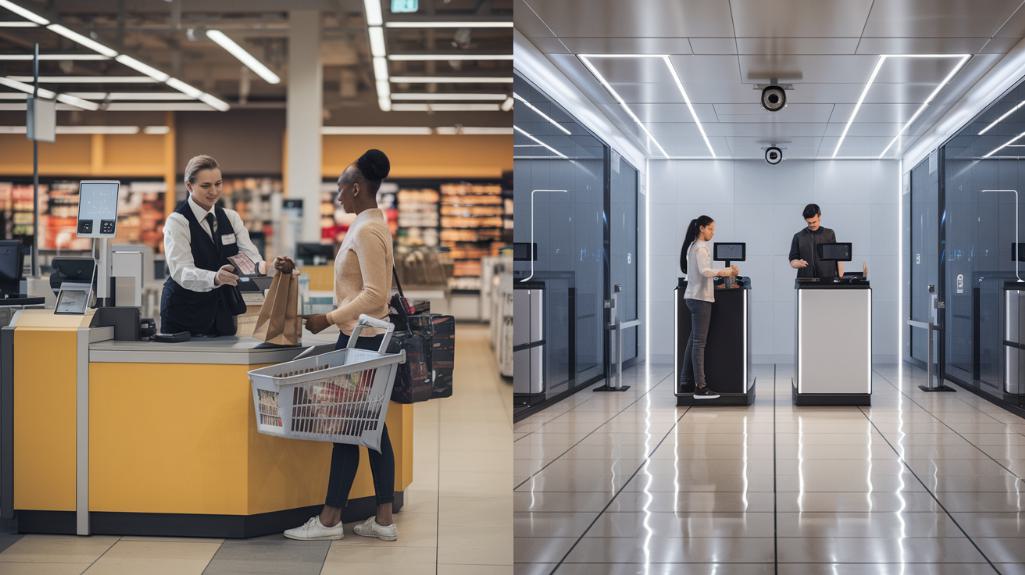
Beyond self-checkout terminals, grab-and-go solutions represent the next evolution in retail automation technology. These AI-driven systems utilize computer vision and sensor fusion to track customer selections, enabling seamless shopping experiences without traditional checkouts. Additionally, AI-powered solutions like ShelfWatch enhance theft prevention, which is crucial for maintaining profitability in grab-and-go environments.
The grab and go benefits for retailers include significant operational efficiency gains through reduced labor costs, improved accuracy in preventing theft, and optimized store layouts. Solutions like Grabango allow customers to skip checkout lines completely with a simple app scan.
Technology integration is streamlined through solutions like AiFi's "store-in-a-box," which can be deployed in various retail environments with minimal disruption to existing infrastructure. The systems integrate with current inventory management platforms while requiring little customer training.
With 50% of consumers anticipating grab-and-go becoming the future standard, retailers can leverage these solutions to enhance customer satisfaction while reducing long-term operational costs through automated processes.
Cost Analysis and ROI Considerations
The initial investment for self-checkout systems ranges considerably from $1,500 for basic models to over $20,000 for advanced configurations, requiring careful budget planning and market analysis. Additionally, implementing a system like Crime Predictor can significantly enhance security by preventing checkout scams and reducing losses. Operating expenses include ongoing maintenance, software updates, and staff training programs, which impact the total cost of ownership over time. Reduced staff presence can lead to higher theft incidents and additional security costs. These investments can be offset by reduced labor costs, increased operational efficiency, and improved space utilization, leading to positive ROI for high-traffic retail environments.
Initial Investment Analysis
As retailers contemplate implementing self-checkout systems, a thorough analysis of initial investment costs and potential returns becomes paramount for informed decision-making. The initial cost ranges markedly from $2,000 to $15,000 per unit, with premium systems exceeding $20,000. Ongoing expenses like maintenance and updates must be carefully considered when evaluating total system costs.
Budget planning must account for these substantial upfront expenses while considering the projected 15% increase in store sales that many grocery retailers experience post-implementation.
- Investment costs vary based on system complexity, features, and integration requirements
- Basic models starting at $1,500 provide entry-level options for smaller retailers
- ROI calculations should factor in labor savings, customer satisfaction, and increased efficiency
- Long-term strategic benefits often outweigh short-term investment challenges through improved sales and operational efficiency
Operating Expense Comparison
While initial investment figures provide a foundation for decision-making, operating expense comparisons reveal the long-term financial implications of self-checkout implementation. The primary cost savings emerge from reduced labor expenses, as one employee can oversee multiple self-checkout stations.
However, these savings must be weighed against increased maintenance, technical support, and loss prevention requirements. The system's effectiveness in streamlining operations allows businesses to redirect resources to other essential areas.
Operating expenses include regular system maintenance, ongoing technical support, and enhanced security measures to combat higher rates of theft and shrinkage.
The shift in labor utilization creates new cost considerations, including staff training for system management and customer assistance.
When evaluating overall operating expenses, retailers must analyze the balance between reduced staffing costs and increased technological overhead, while considering the potential revenue benefits of improved throughput and customer satisfaction.
Customer Experience and Satisfaction Factors
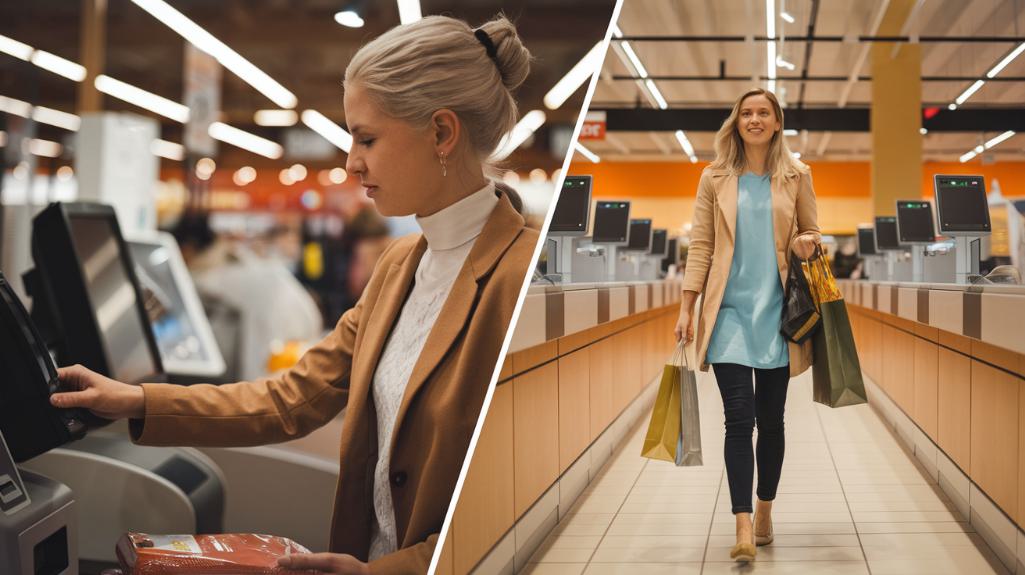
Modern retail data reveals compelling evidence for the growing adoption of self-checkout systems, with over 85% of consumers perceiving them as faster than traditional cashier-led transactions.
Customer preferences strongly favor self-service options, with 73% of shoppers prioritizing speed and convenience. The efficiency gain of 30% in transaction processing demonstrates the tangible benefits of these systems in meeting evolving consumer expectations. The ability to fit four self-checkout units in the space of one traditional checkout lane maximizes store capacity and flow. Additionally, implementing AI-powered systems can further enhance customer interactions by providing tailored promotions at checkout.
Self-service checkout options deliver 30% faster transactions, aligning with the priorities of today's speed-focused consumers.
- Generation Z and Millennials show 23.3% higher preference for self-checkout compared to average consumers
- 79.3% of customers use self-checkout regularly for their purchases
- Self-service provides customers greater control over price verification and transaction accuracy
- Checkout efficiency increases when technology upgrades maintain system functionality
While high adoption rates indicate success, retailers must guarantee consistent system performance to maintain customer satisfaction and maximize the benefits of self-checkout implementation.
Making the Right Choice for Your Business Model
Building on the strong customer adoption rates, businesses must evaluate specific operational and financial factors to determine the best checkout solution for their retail environment. The decision should align with customer demographics, store layout, and technology adoption capabilities while considering the initial capital investment against long-term cost savings.
Key considerations include analyzing store size, product complexity, and customer volume patterns. Larger retailers with high traffic and straightforward merchandise may benefit more from self-checkout systems, leveraging increased throughput and reduced labor costs. With electronic payment terminals, businesses can ensure secure transactions while maintaining efficient operations. Additionally, implementing ScanWatch software can significantly reduce checkout errors, further enhancing operational efficiency.
However, stores with complex inventory or specialized products might require a hybrid approach. Integration with existing POS systems, real-time analytics capabilities, and maintenance requirements should factor into the strategic planning process to guarantee peak operational efficiency and return on investment.
Frequently Asked Questions
How Do Automated Checkout Systems Handle Age-Restricted Products Like Alcohol?
Automated systems suspend transactions during product scanning when age-restricted items are detected. Staff must perform age verification before the transaction can proceed, ensuring compliance with legal requirements.
What Happens During Power Outages With Digital Checkout Systems?
Digital checkout systems rely on UPS backup power for immediate protection during outages. System reliability depends on generators for extended disruptions, ensuring power restoration and maintaining essential transaction capabilities.
Can Customers Use Cash at Grab-And-Go Stores?
Grab-and-go stores typically do not accept cash payment options, focusing instead on digital transactions through mobile apps and cards to maximize efficiency, despite some customer preferences for traditional payment methods.
How Are Pricing Disputes Resolved in Fully Automated Checkout Systems?
Automated systems resolve pricing disputes through real-time monitoring, data-driven verification, and automated mediation tools. Digital receipts and transaction records guarantee pricing accuracy while expediting dispute resolution through integrated platforms.
What Backup Systems Exist When Automated Checkout Technology Fails?
Retail stores maintain manual override procedures, UPS systems, traditional checkout lanes, and emergency support options through IT teams, ensuring continuous operations during technical failures while protecting transaction data integrity.
Conclusion
The choice between self-checkout and automated systems ultimately depends on store size, customer demographics, and operational goals. Retailers must carefully weigh implementation costs against long-term savings, while considering their unique business model and customer preferences. A hybrid approach, combining traditional and modern checkout options, often provides the ideal solution for maximizing efficiency while maintaining service quality and customer satisfaction.

